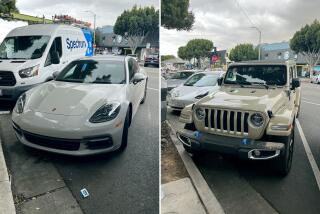A Killer Kia and Other Delights
- Share via
Daewoo Nubira
J.D. Power & Associates places the 2000 Nubira in the “premium compact” class, and who are we to argue?
It is nicely designed in the generic-small-Asian-car school with touches of Italian flair around the nose, and it is plenty comfortable.
The interior color scheme (brown on black on two-tone tan) is a bit busy but nothing to cancel a deal over, and there is enough head- and legroom for a 6-foot-2, 230-pound test driver.
The Nubira is available as a sedan or a station wagon--neat idea that--and its longer-than-average wheelbase of 101.2 inches makes it a pretty smooth traveler.
Base price is $10,990 for the SE model sedan, which comes without air conditioning (a $700 option). The $13,560 CDX model sedan we tested came with a host of standard items including air, power door locks and windows, cruise control, anti-lock brakes and in-dash CD player.
The only big options on the CDX are a power sunroof for $500, leather upholstery for $400 and a four-speed automatic for $800.
The standard five-speed manual transmission does its job, although on our test car the shifter was jiggly and imprecise, making it about as easy to achieve smooth and quick gear changes as it is to rapidly repeat “Nubira” without twisting your tongue around the middle of the word and transforming it to “Nubria.”
Power is plentiful, though not overwhelming, and comes from a 2.0-liter, 16-valve four-banger that puts out 129 horsepower. The engine is licensed from General Motors’ Holden Cars subsidiary in Australia.
Handling is, dare we say it, almost sporty, with tight steering and an independent suspension system that features a beefed-up rear anti-sway bar and stiffer springs for 2000. The 14-inch wheels and tires are adequate, but those who like to drive hard might consider a sportier setup than Daewoo’s stock 185/65R14 size.
Fuel economy is rated by the Environmental Protection Agency at 22 miles per gallon in the city and 31 on the highway.
The trunk is bigger than one would expect in a compact, and the rear seats flip down and lie flat to make loading long items a breeze. And interior noise levels were acceptable for a compact.
Daewoo provides free 24-hour roadside assistance and no-cost scheduled maintenance for three years or 36,000 miles, and this month instituted an additional plan to back its quality claims. Every new Daewoo now comes with a credit, ranging from $825 for the Lanos subcompact to $1,000 for the mid-size Leganza, to cover other maintenance and parts for the first three years--from belts and hoses to brake pads and air and oil filters.
Hyundai Accent
It’s tempting to call this restyled car, available in hatchback and sedan versions, one of the market’s best-kept secrets. Only problem is that the 2000 Accent is no longer a secret. It has become the best-selling economy compact in the U.S.
Granted, that’s a pretty uncrowded market--the Accent, Toyota Echo and Chevrolet Metro account for eight of every 10 sales--but with the Accent outselling the Echo by a 30% margin, Hyundai can claim some pretty bold bragging rights.
Part of Hyundai’s success is the Metro’s absolute lack of any selling points (Chevy is discontinuing retail sales of the car this year and will use it only for commercial fleet sales in the future) and the Toyota’s awkward, polarizing style, which leaves nobody ambivalent and quite a few lined up on the “hate it” side of the ledger.
Add to that Hyundai’s 10-year, 100,000-mile powertrain warranty; five-year, 60,000-mile bumper-to-bumper coverage; five-year free 24-hour roadside assistance program; and a price range that runs from $8,999 for the base L model two-door hatchback to $9,699 for the top-of-the-line GL sedan--and it’s little wonder that shoppers are taking a look and Hyundai’s 575 dealers are reprogramming their cell phones with the long-forgotten numbers of travel agents, cigar shops and wine merchants.
The Accent is not a car you would want to put on the track. Its narrow 175/70R13 tires limit its cornering abilities, and the 1.5-liter, 92-horsepower engine gets awfully sluggish at speeds above 65--with either the standard manual five-speed transmission or the $600 optional four-speed automatic.
But the car is at home in city traffic, where its compactness and quick steering make maneuvering fairly pleasant. Independent suspension is nice on smooth roads but can get a bit bouncy on rough or undulating surfaces.
Fuel economy is EPA-rated at 28 mpg around town and 36 on the highway (subtract 2 mpg in each category for the automatic).
Fit and finish are good, the trunk is big enough for a weekend’s worth of luggage, and up front the seats and headroom will easily accommodate a pair of 6-footers. There’s headroom in the rear seating area for 6-footers, too, but the passenger behind a tall driver had better like chewing on his or her knees.
Hyundai’s noise and vibration controls have steadily improved with time, but you can still hear the Accent’s engine while accelerating, whether Tchaikovsky’s “1812” Overture or T Rex’s “Bang a Gong” is blaring from the optional CD player. Other options include air conditioning, anti-lock brakes and power windows and door locks.
Kia Spectra
This could be Kia’s chance to gain a little respect among the key youth crowd. While the Spectra--which will hit showrooms this month--shares the plain-vanilla Sephia’s platform, including suspension, power plant and drive train, it looks better.
And as Kia’s own ads point out, this is the land where looks and money are everything.
The five-passenger, four-door Spectra hatchback starts at $10,795. It tops out, fully loaded (with four-speed automatic transmission; cruise control; air conditioning; anti-lock brakes; CD player; keyless entry; power windows, door locks and mirrors; leather-wrapped steering wheel; alloy wheels; rear spoiler and a few other trim goodies), at $16,000.
In the looks department, while it is no Aston Martin, or even an Acura, the Spectra has enough swoop and bulge to be visually interesting (note, it is a car that is not done any justice by its photos, which tend to flatten out the lines).
Although Kia calls it a five-place vehicle and provides rear seat belts for three, the Spectra will do better as a four-seater. There is plenty of room up front, though, and the bucket seats are comfortable even for a fairly hefty driver.
The Spectra is EPA-rated at 23 mpg in the city, 29 on the highway.
Kia’s 1.8-liter engine puts out a respectable 125 horsepower. That, coupled with the standard five-speed manual transmission, was able to push it up and down Nevada’s Spring Mountains and through the Pahrump Valley with little strain during a recent test drive.
The interior is fairly basic but nicely arranged so that everything the driver needs is close at hand--or eye. Especially beneficial: the first Kia radio with control buttons large enough to be found without the aid of a magnifying glass. There was some road and engine noise, but with air conditioning on and windows up, the levels were quite acceptable.
Rear storage (the trunk, if it weren’t a hatchback) is plentiful for a small car, and the standard 60-40 split rear seats fold down to make for added cargo room.
To show off Spectra’s possibilities, Kia recently did a brave thing and put four of them, mildly modified by performance whiz Oscar Jackson of Jackson Racing, onto a 2.5-mile road track in Pahrump and gave they keys to a group of automotive writers.
The cars, which also sported special $3,000 paint jobs, were equipped with about $2,000 of aftermarket equipment--improved air filters and exhaust systems; stiffer springs; a heftier clutch and shorter shift linkage; and 16-inch wheels and high-performance tires. The difference was remarkable.
They gained about 7 horsepower from the modified breathing apparatus--and that, with the new clutch, tight shift pattern, heftier suspension parts and bigger rubber, made it fun to hurl them into tight corners and easy to control them coming out.
It might be worth Kia’s while to put the performance package together as an additional option--or, better yet, as standard equipment with as little markup as possible. That could go a long way toward putting more Kias on the road.






